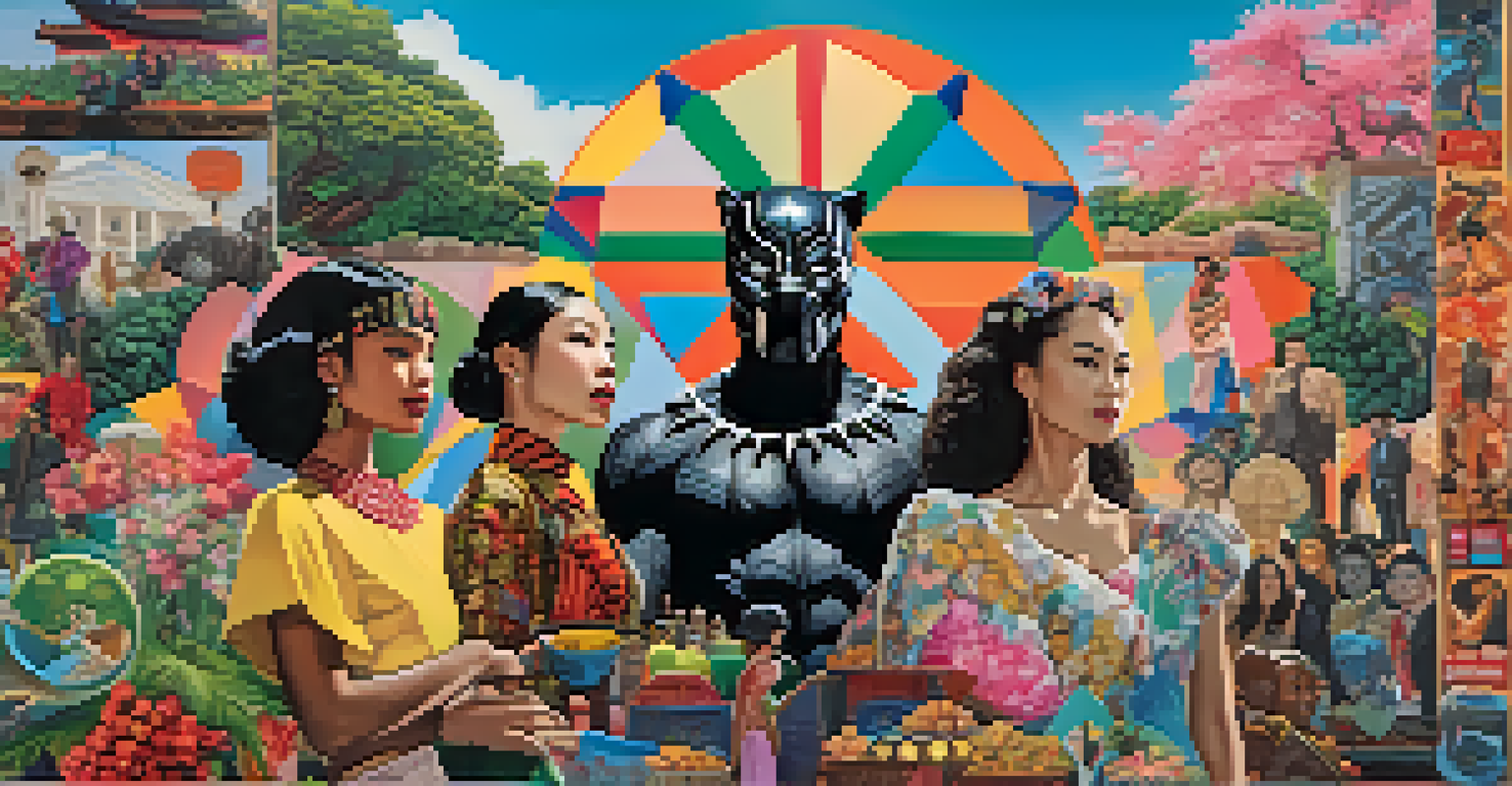The Role of Culture in Shaping Filmic Identities

Understanding Filmic Identities Through Cultural Lenses
Filmic identities are shaped by the cultural contexts in which films are created. These identities reflect the values, beliefs, and traditions of the communities that produce them. For instance, a film made in Japan might incorporate elements of Shinto mythology, showcasing how culture informs storytelling.
Cinema is a matter of what's in the frame and what's out.
Moreover, cultural influences can alter how audiences perceive and relate to characters and narratives. When a viewer recognizes familiar cultural motifs, it helps forge a deeper connection with the film. This is why films like 'Crouching Tiger, Hidden Dragon' resonate globally while remaining rooted in Chinese culture.
Ultimately, understanding filmic identities requires us to consider the interplay between culture and cinema. By examining films through this lens, we can appreciate the diverse narratives that emerge and the cultural richness they convey.
Cultural Representation: A Double-Edged Sword
Cultural representation in film can be both empowering and limiting. On one hand, films that depict authentic cultural experiences can validate and celebrate underrepresented communities. For example, movies like 'Black Panther' not only showcase African culture but also inspire pride and identity among viewers.

On the other hand, misrepresentation or stereotyping can lead to a skewed understanding of a culture. Films that rely on clichés or one-dimensional portrayals can perpetuate harmful stereotypes, as seen in some Western films that depict Eastern cultures. This underscores the need for filmmakers to approach cultural representation with sensitivity and authenticity.
Cultural Context Shapes Film Narratives
Films reflect their cultural contexts, which inform storytelling and character development.
Striking the right balance in cultural representation is vital. By promoting diverse narratives and collaborating with cultural insiders, filmmakers can create more nuanced and accurate portrayals that resonate with audiences.
Cultural Context: The Backbone of Film Narratives
Every film exists within a specific cultural context that informs its narrative. This context can include historical events, social movements, and prevailing attitudes. For example, films set during the Civil Rights Movement often reflect the struggles and triumphs of that era, providing audiences with a lens into a pivotal moment in history.
The beauty of cinema is that it can tell stories that are true to our culture, while also being universal.
Additionally, cultural context can influence genre preferences and storytelling styles. A romantic comedy in one culture might differ significantly from another due to varying societal norms and expectations surrounding love and relationships. Understanding these differences enriches our appreciation of global cinema.
Thus, analyzing the cultural context of a film offers valuable insights into its narrative choices and character development. It helps us see how filmmakers respond to and reflect the world around them.
The Globalization of Film and Cultural Exchange
Globalization has transformed the film industry, facilitating cultural exchange on an unprecedented scale. Films from different countries are now more accessible to international audiences, leading to a blend of influences and styles. For instance, Bollywood films have gained popularity outside India, introducing viewers to vibrant narratives and cultural elements.
This exchange can enrich storytelling, as filmmakers draw inspiration from diverse cultures. Collaborations between creators from different backgrounds can yield innovative films that resonate with global audiences. A great example is the collaboration seen in 'Parasite,' which won international acclaim while highlighting South Korean societal issues.
Cultural Representation Matters
Authentic cultural representation in film can empower communities, while misrepresentation can perpetuate stereotypes.
However, this globalization also raises questions about cultural appropriation and authenticity. It's essential for filmmakers to navigate these complexities with respect, ensuring that cultural elements are integrated thoughtfully rather than exploitatively.
The Role of Audience in Shaping Filmic Identities
Audiences play a crucial role in shaping filmic identities through their interpretations and reactions. Viewer engagement can influence the success of a film, prompting filmmakers to consider cultural relevance. For example, a film that resonates with audiences may inspire sequels or spin-offs that further explore its cultural themes.
Moreover, audience feedback can drive filmmakers to address cultural issues more thoughtfully. Social media platforms have given viewers a voice, allowing them to critique and celebrate representations in film. This dynamic interaction encourages filmmakers to be more aware of how their work impacts cultural narratives.
Ultimately, the interplay between film and audience underscores the evolving nature of filmic identities. As audiences become more diverse and vocal, filmmakers are challenged to create content that reflects a broader range of experiences.
Cultural Identity and the Rise of Independent Cinema
Independent cinema often serves as a platform for exploring cultural identities that mainstream films may overlook. These films frequently depict personal stories that resonate with specific cultural backgrounds, allowing for a more intimate portrayal of identity. For example, films like 'The Farewell' highlight the complexities of cultural identity in the diaspora.
Indie filmmakers often prioritize authenticity over commercial appeal, leading to narratives that authentically represent cultural experiences. This authenticity can challenge stereotypes and provoke meaningful conversations about identity and belonging. As viewers engage with these stories, they gain insights into the lives and struggles of different communities.
Globalization Fuels Cultural Exchange
The globalization of film enhances cultural exchange, allowing diverse influences to enrich storytelling.
In this way, independent cinema plays a vital role in diversifying the film landscape. By showcasing a variety of cultural identities, it enriches the cinematic world and fosters greater understanding among audiences.
Future Directions: Cultural Hybridity in Film
As the film industry continues to evolve, cultural hybridity is becoming a prominent trend. This blending of cultures in storytelling allows filmmakers to create rich narratives that reflect our increasingly interconnected world. For instance, films like 'Crazy Rich Asians' combine elements from various cultures, appealing to a broad audience while celebrating specific cultural nuances.
Cultural hybridity also challenges traditional notions of identity, encouraging viewers to embrace fluidity in how they understand culture. This can lead to innovative storytelling that transcends geographical boundaries, making room for fresh perspectives. It's a fascinating shift that invites audiences to reevaluate their own cultural identities.

Looking ahead, the embrace of cultural hybridity in film promises to open new avenues for storytelling. As filmmakers continue to explore these intersections, we can expect a vibrant cinematic landscape that reflects the diverse tapestry of human experience.